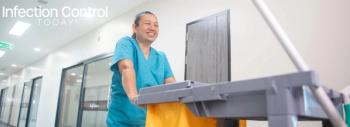
Researchers Evaluate Hand-Held Far-Ultraviolet Radiation Device for Decontamination
Environmental surfaces play an important role in transmission of healthcare-associated pathogens. There is a need for new disinfection methods that are effective against Clostridium difficile spores, but also safe and rapid. The Sterilray Disinfection Wand device is a hand-held room decontamination technology that utilizes far-ultraviolet radiation (185-230 nm) to kill pathogens.
Â
Nerandzic, et al. (2012) examined the efficacy of disinfection using the Sterilray device in the laboratory, in rooms of hospitalized patients, and on surfaces outside of patient rooms (i.e. keyboards and portable medical equipment). Cultures for C. difficile, methicillin-resistant Staphylococcus aureus (MRSA), and vancomycin-resistant Enterococcus (VRE) were collected from commonly-touched surfaces before and after use of the Sterilray device.
On inoculated surfaces in the laboratory, application of the Sterilray device at a radiant dose of 100 mJ/cm2 for ~ 5 seconds consistently reduced recovery of C. difficile spores by 4.4 CFU log10, MRSA by 5.4 log10CFU and of VRE by 6.9 log10CFU. A >3 log10 reduction of MRSA and VRE was achieved in ~2 seconds at a lower radiant dose, but killing of C. difficile spores was significantly reduced. On keyboards and portable medical equipment that were inoculated with C. difficile spores, application of the Sterilray device at a radiant dose of 100 mJ/cm2 for ~ 5 seconds reduced contamination by 3.2 log10CFU. However, the presence of organic material reduced the lethal effect of the far-UV radiation. In hospital rooms that were not pre-cleaned, disinfection with the Sterilray device significantly reduced the frequency of positive C. difficile and MRSA cultures (P =0.007).
Â
The researchers say that the Sterilray Disinfection Wand is a novel environmental disinfection technology that rapidly kills C. difficile spores and other healthcare-associated pathogens on surfaces. However, the presence of organic matter reduces the efficacy of far-UV radiation, possibly explaining the more modest results observed on surfaces in hospital rooms that were not pre-cleaned.
Reference: Nerandzic MM, Cadnum JL, Eckart KE and Donskey CJ. Evaluation of a hand-held far-ultraviolet radiation device for decontamination of Clostridium difficile and other healthcare-associated pathogens. BMC Infectious Diseases 2012, 12:120 doi:10.1186/1471-2334-12-120
Newsletter
Stay prepared and protected with Infection Control Today's newsletter, delivering essential updates, best practices, and expert insights for infection preventionists.





